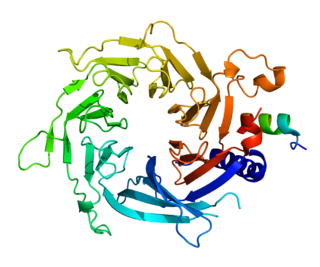Methyl-CpG-binding domain protein 2 is a protein that in humans is encoded by the MBD2 gene. [5] [6]
Methyl-CpG-binding domain protein 2 is a protein that in humans is encoded by the MBD2 gene. [5] [6]
DNA methylation is the major modification of eukaryotic genomes and plays an essential role in mammalian development. Human proteins MECP2, MBD1, MBD2, MBD3, and MBD4 comprise a family of nuclear proteins related by the presence in each of a methyl-CpG-binding domain (MBD). Each of these proteins, with the exception of MBD3, is capable of binding specifically to methylated DNA. MECP2, MBD1, and MBD2 can also repress transcription from methylated gene promoters. The protein encoded by these genes may function as a mediator of the biological consequences of the methylation signal. It is also reported that MBD2 and MBD3 recruit the NuRD complex to regions of DNA depending on their selective binding of methylated CpG sites. Therefore, MBD2/NuRD and MBD3/NuRD define two distinct protein complexes with different biochemical and functional properties. [7]
Methyl-CpG-binding domain protein 2 has been shown to interact with:

Histone methyltransferases (HMT) are histone-modifying enzymes, that catalyze the transfer of one, two, or three methyl groups to lysine and arginine residues of histone proteins. The attachment of methyl groups occurs predominantly at specific lysine or arginine residues on histones H3 and H4. Two major types of histone methyltranferases exist, lysine-specific and arginine-specific. In both types of histone methyltransferases, S-Adenosyl methionine (SAM) serves as a cofactor and methyl donor group.
The genomic DNA of eukaryotes associates with histones to form chromatin. The level of chromatin compaction depends heavily on histone methylation and other post-translational modifications of histones. Histone methylation is a principal epigenetic modification of chromatin that determines gene expression, genomic stability, stem cell maturation, cell lineage development, genetic imprinting, DNA methylation, and cell mitosis.

Methyl-CpG-binding domain protein 1 is a protein that in humans is encoded by the MBD1 gene. The protein encoded by MBD1 binds to methylated sequences in DNA, and thereby influences transcription. It binds to a variety of methylated sequences, and appears to mediate repression of gene expression. It has been shown to play a role in chromatin modification through interaction with the histone H3K9 methyltransferase SETDB1. H3K9me3 is a repressive modification.

Histone deacetylase 1 (HDAC1) is an enzyme that in humans is encoded by the HDAC1 gene.

The nuclear receptor co-repressor 1 also known as thyroid-hormone- and retinoic-acid-receptor-associated co-repressor 1 (TRAC-1) is a protein that in humans is encoded by the NCOR1 gene.

Histone deacetylase 2 (HDAC2) is an enzyme that in humans is encoded by the HDAC2 gene. It belongs to the histone deacetylase class of enzymes responsible for the removal of acetyl groups from lysine residues at the N-terminal region of the core histones. As such, it plays an important role in gene expression by facilitating the formation of transcription repressor complexes and for this reason is often considered an important target for cancer therapy.

Paired amphipathic helix protein Sin3a is a protein that in humans is encoded by the SIN3A gene.

Histone-binding protein RBBP4 is a protein that in humans is encoded by the RBBP4 gene.

Histone-binding protein RBBP7 is a protein that in humans is encoded by the RBBP7 gene.

C-terminal-binding protein 1 also known as CtBP1 is a protein that in humans is encoded by the CTBP1 gene. CtBP1 is one of two CtBP proteins, the other protein being CtBP2.

Myocyte-specific enhancer factor 2A is a protein that in humans is encoded by the MEF2A gene. MEF2A is a transcription factor in the Mef2 family. In humans it is located on chromosome 15q26. Certain mutations in MEF2A cause an autosomal dominant form of coronary artery disease and myocardial infarction.

Methyl-CpG-binding domain protein 3 is a protein that in humans is encoded by the MBD3 gene.

Eukaryotic translation initiation factor 3 subunit A (eIF3a) is a protein that in humans is encoded by the EIF3A gene. It is one of the subunits of Eukaryotic initiation factor 3 (eIF3) a multiprotein complex playing major roles in translation initiation in eukaryotes.

Sin3A-associated protein, 30kDa, also known as SAP30, is a protein which in humans is encoded by the SAP30 gene.

Chromodomain-helicase-DNA-binding protein 4 is an enzyme that in humans is encoded by the CHD4 gene.

Polycomb protein EED is a protein that in humans is encoded by the EED gene.

Metastasis-associated protein MTA2 is a protein that in humans is encoded by the MTA2 gene.

Paired amphipathic helix protein Sin3b is a protein that in humans is encoded by the SIN3B gene.

Histone H4 transcription factor is a protein that in humans is encoded by the HINFP gene.

Transcriptional repressor p66-beta is a protein that in humans is encoded by the GATAD2B gene.
In the field of molecular biology, the Mi-2/NuRDcomplex, is a group of associated proteins with both ATP-dependent chromatin remodeling and histone deacetylase activities. As of 2007, Mi-2/NuRD was the only known protein complex that couples chromatin remodeling ATPase and chromatin deacetylation enzymatic functions.